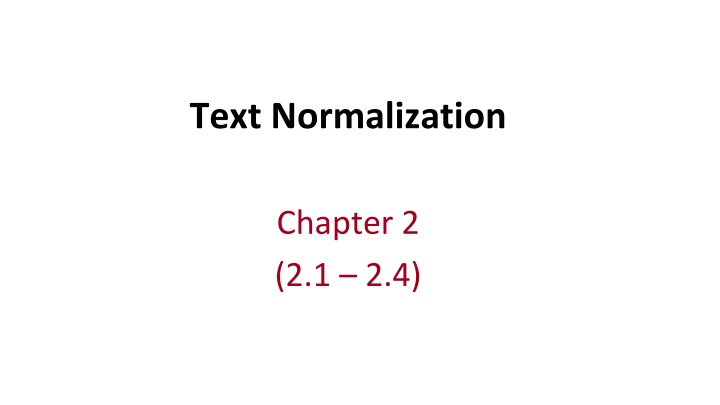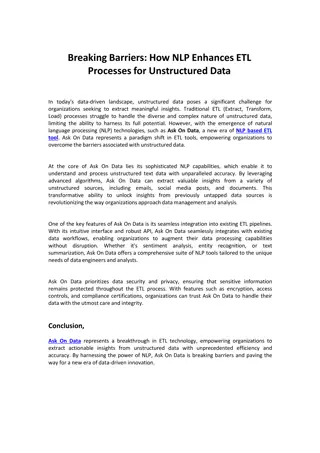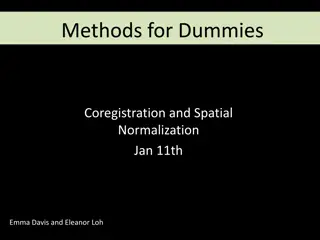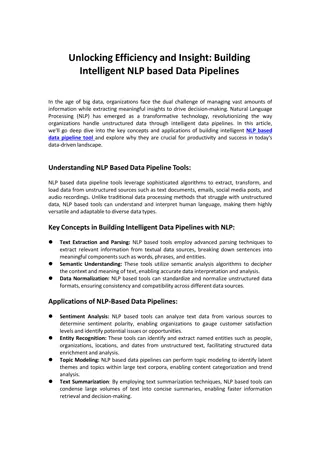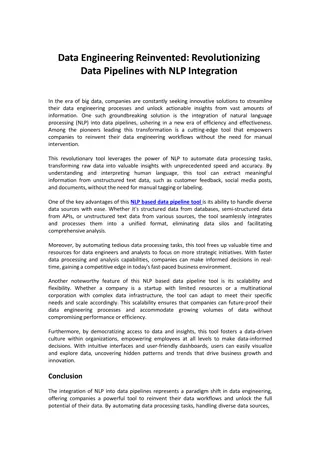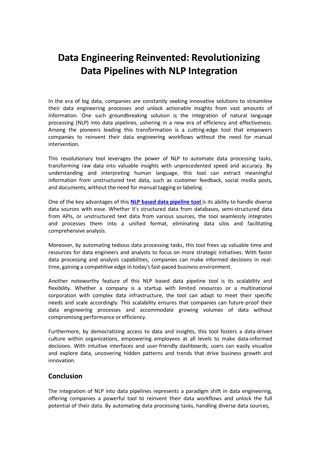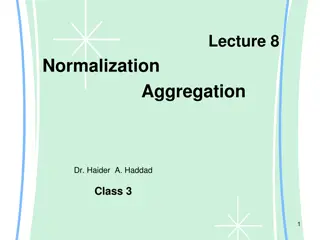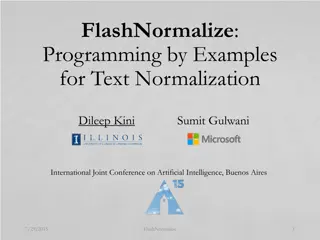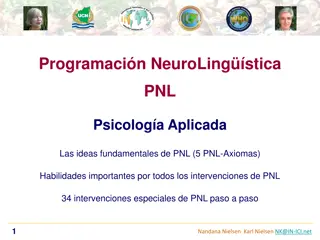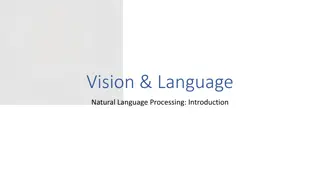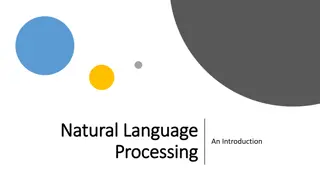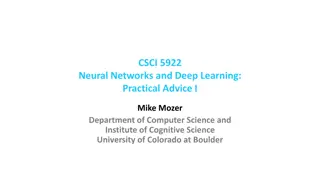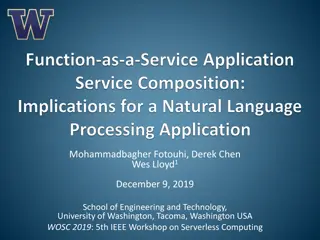Text Normalization and Basic Text Processing in NLP
Regular expressions, errors, and the importance of text normalization and word tokenization in natural language processing (NLP) are explored in this comprehensive guide. Learn about the role of regular expressions, common errors in NLP tasks, and the significance of accurate text normalization for various NLP applications. Discover how word tokenization aids in improving the efficiency of NLP tasks by segmenting, normalizing, and processing text data. Gain insights into reducing errors in NLP tasks through precision and recall optimization.
Download Presentation

Please find below an Image/Link to download the presentation.
The content on the website is provided AS IS for your information and personal use only. It may not be sold, licensed, or shared on other websites without obtaining consent from the author.If you encounter any issues during the download, it is possible that the publisher has removed the file from their server.
You are allowed to download the files provided on this website for personal or commercial use, subject to the condition that they are used lawfully. All files are the property of their respective owners.
The content on the website is provided AS IS for your information and personal use only. It may not be sold, licensed, or shared on other websites without obtaining consent from the author.
E N D
Presentation Transcript
Text Normalization Chapter 2 (2.1 2.4)
Basic Text Processing Regular Expressions
Regular expressions A formal language for specifying text strings How can we search for any of these? woodchuck woodchucks Woodchuck Woodchucks Ill vs. illness color vs. colour
Example Does $> grep elect news.txt return every line in a file called news.txt that contains the word elect elect Misses capitalized examples [eE]lect Incorrectly returns select or electives [^a-zA-Z][eE]lect[^a-zA-Z]
Errors The process we just went through was based on fixing two kinds of errors Matching strings that we should not have matched (there, then, other) False positives (Type I) Not matching things that we should have matched (The) False negatives (Type II)
Errors cont. In NLP we are always dealing with these kinds of errors. Reducing the error rate for an application often involves two antagonistic efforts: Increasing accuracy or precision (minimizing false positives) Increasing coverage or recall (minimizing false negatives).
Summary Regular expressions play a surprisingly large role Sophisticated sequences of regular expressions are often the first model for any text processing text I am assuming you know, or will learn, in a language of your choice For many hard tasks, we use machine learning classifiers But regular expressions are used as features in the classifiers Can be very useful in capturing generalizations 7
Basic Text Processing Word tokenization
Text Normalization Every NLP task needs to do text normalization: 1. Segmenting/tokenizing words in running text 2. Normalizing word formats 3. Segmenting sentences in running text
How many words? I do uh main- mainly business data processing Fragments, filled pauses Terminology Lemma: same stem, part of speech, rough word sense cat and cats = same lemma Wordform: the full inflected surface form cat and cats = different wordforms
How many words? they lay back on the San Francisco grass and looked at the stars and their Type: an element of the vocabulary. Token: an instance of that type in running text. How many? 15 tokens (or 14) 13 types (or 12) (or 11?)
How many words? N = number of tokens V = vocabulary = set of types |V|is the size of the vocabulary Tokens = N Types = |V| Switchboard phone conversations 2.4 million 20 thousand Shakespeare 884,000 31 thousand Google N-grams 1 trillion 13 million
Issues in Tokenization Finland s capital what re, I m, isn t state-of-the-art San Francisco
Issues in Tokenization Finland Finlands Finland s ? Finland s capital what re, I m, isn t What are, I am, is not state-of-the-art state of the art ? San Francisco one token or two?
Tokenization: language issues Chinese and Japanese no spaces between words: Sharapova now lives in US southeastern Florida
Basic Text Processing Word Normalization and Stemming
Normalization Need to normalize terms Information Retrieval: indexed text & query terms must have same form. We want to match U.S.A. and USA We implicitly define equivalence classes of terms e.g., deleting periods in a term Alternative: asymmetric expansion: Enter: windows Search: Windows, windows, window Potentially more powerful, but less efficient
Case folding Applications like IR: reduce all letters to lower case Since users tend to use lower case Possible exception: upper case in mid-sentence? e.g., General Motors Fed vs. fed SAIL vs. sail For sentiment analysis, MT, Information extraction Case is helpful (US versus us is important)
Lemmatization Reduce inflections or variant forms to base form am, are,is be car, cars, car's, cars' car the boy's cars are different colors the boy car be different color Lemmatization: have to find correct dictionary headword form
Morphology Morphemes: The small meaningful units that make up words Stems: The core meaning-bearing units Affixes: Bits and pieces that adhere to stems Often with grammatical functions
Stemming Reduce terms to their stems in information retrieval Stemming is crude chopping of affixes language dependent e.g., automate(s), automatic, automation all reduced to automat. for example compressed and compression are both accepted as equivalent to compress. for exampl compress and compress ar both accept as equival to compress
Sentence Segmentation !, ? are relatively unambiguous Period . is quite ambiguous Sentence boundary Abbreviations like Inc. or Dr. Numbers like .02% or 4.3 Build a binary classifier Looks at a . Decides EndOfSentence/NotEndOfSentence Classifiers: hand-written rules, regular expressions, or machine-learning
